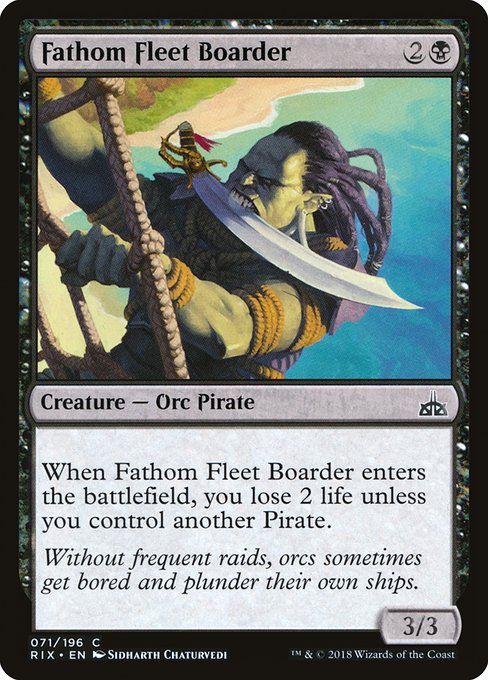
Image courtesy of Scryfall.com
Templating and Player Insight: Fathom Fleet Boarder
In Magic: The Gathering, the way a card is worded can be just as influential as the card’s power and toughness. Templating—the deliberate phrasing of abilities—shapes not only what happens on the battlefield but how players interpret risk, tempo, and tribal synergy. Fathom Fleet Boarder, a Rivals of Ixalan common, is a compact tuition in how a single line of text guides decision-making. With a mana cost of {2}{B} and a sturdy 3/3 body, this Orc Pirate lands on turn three with a bang—if you read the sentence just right. The real teaching moment hides in the trigger: “When this creature enters, you lose 2 life unless you control another Pirate.” 🧙♂️
The templating here does two crucial things. First, it makes the moment of entry a deliberate choice rather than a passive event. You don’t instantly pay a life toll because you played a 3-drop; you pay it unless you’ve already established another Pirate on the battlefield. That nuance nudges players toward Pirate tribal planning: you’re encouraged to pilot a deck that can flood the board with pirates, or at least ensure you don’t walk into the life loss solo. The second signal is the “another Pirate” clause, which prevents the card from double-dipping on itself to avoid the penalty. This not only preserves the consistency of the mechanic across a whole tribe but also reinforces a mental model: a Pirate deck is not just about one strong recruit, it’s about a chorus of marauders that can back each other up. 🔥
From a gameplay perspective, the Boarder’s templating embodies black’s risk-reward ethos without tipping into arithmetic complexity. You’re trading a potential life loss for board presence, and the cost is entirely conditional on your board state. If you already control another Pirate (perhaps a lategame threat or a token swarm), the entry is clean and efficient—a respectable tempo play for a 3/3 creature. If not, you’ll need to weigh whether dropping this card now buys enough advantage to justify taking 2 damage. In either case, the text is unambiguous enough for new players to grasp quickly, yet nuanced enough for seasoned players to appreciate the subtle timing implications. ⚔️
Rivals of Ixalan is a set built around pirates, raiders, and a splash of orc bravado, and Fathom Fleet Boarder sits squarely at that crossroads. The flavor text—“Without frequent raids, orcs sometimes get bored and plunder their own ships.”—adds a wink to the templating itself: the card’s narrative supports the mechanical design. The orc crew runs hot when the tide turns, and the card’s ability mirrors that instinct—sometimes you need risk (life loss) to keep the raid rolling. The 3/3 body for 3 mana remains a solid floor, making this a reliable staple in black Pirate shells or in more general RB (Rakdos-ish) tempo decks. 💎
From a deck-building perspective, the Boarder nudges players toward synergy. Pirate tribes have long leaned on a shared identity—livening up the battlefield with marauders who feed off each other’s presence. The templating makes this explicit: you’ll want another Pirate on board to avoid life loss, which naturally pushes you toward multi-Pirate plays rather than lone-wolf gambits. That shape is not just a mechanical snare; it’s a design cue that guides players toward exploring tribal synergies, sideboard considerations, and synergy-driven tempo. In a world of increasingly complex templating, it’s refreshing to see a line that remains approachable while still inviting deeper tactical engagement. 🧭
And there’s more to templating than raw numbers. The choice of “enters the battlefield” rather than “enters the play” is a subtle but meaningful one. It aligns with how players actually experience the moment as a battlefield state change, not an abstract card-draw event. That alignment—between what players feel and what the words say—helps reduce cognitive friction for newcomers while giving veterans a clean, predictable rule set to exploit in combos and synergies. The Boarder thus serves as a small lighthouse for how Wizards of the Coast has refined templating in modern sets: readable, actionable, and flavor-consistent. 🎨
As you explore pirate-themed decks or even a broader black-based tempo shell, the Boarder’s templating invites creative planning. It’s not merely about playing a 3/3; it’s about reading the board state and recognizing the moment when you’re ready to swing for a raid—and knowing that your next pirate on the field could turn a near-miss into a momentum swing. If you’re a collector or a player who enjoys the interplay of tribe and tempo, this card is a quiet reminder of how elegant a well-crafted line can be. The more you study the phrasing, the more you appreciate the difference between a card that simply works and a card that teaches you to think like the player who designed it. 🧙♂️🔥
Beyond the battlefield, templating shapes our understanding of the game’s rituals. The Boarder demonstrates how a single line can influence deck-building culture, turn-by-turn decisions, and even the way new players approach the game. It’s a microcosm of MTG’s long love affair with words—the poetry of a well-placed semicolon, the drama of an if-then clause, and the evergreen thrill of a perfect tempo play. If you’re new to the game or revisiting your pirates, keep an eye on how your own drafting and gameplay habits shift as you become fluent in the language of templating. 🪙
MagSafe Phone Case with Card Holder Glossy Matte PolycarbonateMore from our network
- https://blog.digital-vault.xyz/blog/post/from-sketch-to-sprite-pixel-art-assets-for-game-developers/
- https://blog.digital-vault.xyz/blog/post/hakamo-o-cosplay-and-fan-art-spotlight/
- https://blog.digital-vault.xyz/blog/post/blue-hot-scorpius-giant-illuminates-galactic-motion/
- https://crypto-acolytes.xyz/blog/post/navigating-ais-impact-on-virtual-economies/
- https://blog.digital-vault.xyz/blog/post/easter-eggs-and-hidden-design-jokes-in-innovative-metatect/